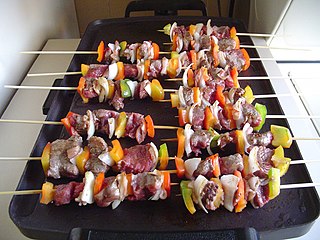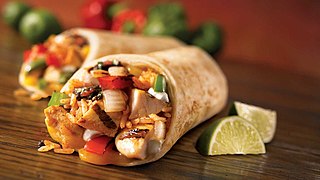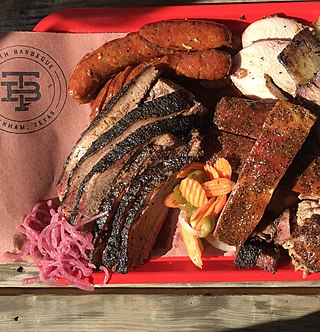
A fajita, in Tex-Mex cuisine, is any stripped grilled meat, optionally served with stripped peppers and onions usually served on a flour or corn tortilla. The term originally referred to skirt steak, the cut of beef first used in the dish. Popular alternatives to skirt steak include chicken and other cuts of beef, as well as vegetables instead of meat. In restaurants, the meat is usually cooked with onions and bell peppers. Popular condiments include shredded lettuce, sour cream, guacamole, salsa, pico de gallo, shredded cheese, refried beans, and diced tomatoes. "Tacos de arrachera" is applied to the northern Mexican variant of the dish.

South American cuisine has many influences, due to the ethnic fusion of South America. The most characteristic are Native American, African, Spanish, Italian, Portuguese, and Indian-South Asian. However, there is a mix of European, North American, and indigenous cuisines. The customs and food products greatly vary according to the physically distinct regions.

Chorizo is a type of pork sausage originating from the Iberian Peninsula. It is made in many national and regional varieties in several countries on different continents. Some of these varieties are quite different from each other, occasionally leading to confusion or disagreements over the names and identities of the products in question.

Asado is the technique and the social event of having or attending a barbecue in various South American countries: especially Argentina, Chile, Paraguay, Peru, and Uruguay where it is also a traditional event. An asado usually consists of beef, pork, chicken, chorizo, and morcilla; all of which are cooked using an open fire or a grill, called a parrilla. Usually, red wine and side dishes such as salads accompany the main meats, which are prepared by a designated cook called the asador or parrillero.

Chicharrón is a dish generally consisting of fried pork belly or fried pork rinds. Chicharrón may also be made from chicken, mutton, or beef.

New Mexican cuisine is the cuisine of the Southwestern US state of New Mexico. The region is primarily known for its fusion of Pueblo Native American cuisine with Hispano Spanish and Mexican cuisine originating in Nuevo México. This Southwestern culinary style is popular beyond the current boundaries of New Mexico, and is found throughout the old territories of Nuevo México and the New Mexico Territory, today the state of Arizona, parts of Texas, and the southern portions of Colorado, Utah, and Nevada.

Al pastor, tacos al pastor, or tacos de trompo is a preparation of spit-grilled slices of pork originating in the Central Mexican region of Puebla and Mexico City, although today it is a common menu item found in taquerías throughout Mexico but most prominently is from these two parts of the country, where it is largely found. The method of preparing and cooking al pastor is based on the lamb shawarma brought by Lebanese immigrants to the region. Al pastor features a flavor palate that uses traditional Mexican adobada (marinade). It is a popular street food that has spread to the United States. In some places of northern Mexico and coastal Mexico, such as in Baja California, taco al pastor is known as taco de trompo or taco de adobada.

Barbecue varies by the type of meat, sauce, rub, or other flavorings used, the point in barbecuing at which they are added, the role smoke plays, the equipment and fuel used, cooking temperature, and cooking time.

Adobada is a preparation for many dishes that are common in Mexican cuisine. Adobada is generally pork marinated in a "red" chili sauce with vinegar and oregano, but it can refer to different types of meat and to marinades closer to al pastor. It is generally served on small, pliable maize tortilla along with sautéed vegetables and cheese.

Honduran cuisine is a fusion of Mesoamerican, Spanish, Caribbean and African cuisines. There are also dishes from the Garifuna people. Coconut and coconut milk are featured in both sweet and savory dishes. Regional specialties include sopa de caracol, fried fish, tamales, carne asada and baleadas. Other popular dishes include meat roasted with chismol and carne asada, chicken with rice and corn, and fried fish with pickled onions and jalapeños. In the coastal areas and the Bay Islands, seafood and some meats are prepared in many ways, including with coconut milk. Among the soups the Hondurans enjoy are bean soup, mondongo soup, seafood soups and beef soups. Generally all of these soups are mixed with plantains, yuca, and cabbage, and served with corn tortillas.

Flap steak, or flap meat is a beef steak cut from the obliquus internus abdominis muscle of the bottom sirloin. It is generally very thin, fibrous and chewy, but flavorful, and often confused with both skirt steak and hanger steak.

Carne asada fries are a local dish speciality found on the menus of restaurants primarily in the American Southwest, including San Diego, where it originated.

Many regional cuisines feature a mixed grill, a dish consisting of an assortment of grilled meats.

A burrito in Mexico is, historically, a regional name, among others, for what is known as a taco, a tortilla filled with food, in other parts of the country. The term burrito was regional, specifically from Guanajuato, Guerrero, Michoacán, San Luis Potosí and Sinaloa, for what is known as a taco in Mexico City and surrounding areas, and codzito in Yucatán and Quintana Roo. Due to the cultural influence of Mexico City, the term taco became the default, and the meaning of terms like burrito and codzito were forgotten, leading many people to create new meanings and folk histories.

Texan cuisine is the food associated with the Southern U.S. state of Texas, including its native Southwestern cuisine–influenced Tex-Mex foods. Texas is a large state, and its cuisine has been influenced by a wide range of cultures, including Tejano/Mexican, Native American, Creole/Cajun, African-American, German, Czech, Southern and other European American groups. The cuisine of neighboring states also influences Texan cuisine, such as New Mexican cuisine and Louisiana Creole cuisine. This can be seen in the widespread usage of New Mexico chiles, Cayenne peppers, and Tabasco sauce in Texan cooking.

Shredded beef, also known as pulled beef, is a preparation of beef that features in dishes from various cuisines. Shredded beef is sometimes prepared using beef brisket and chuck roast. Pot roast is also sometimes shredded.






























